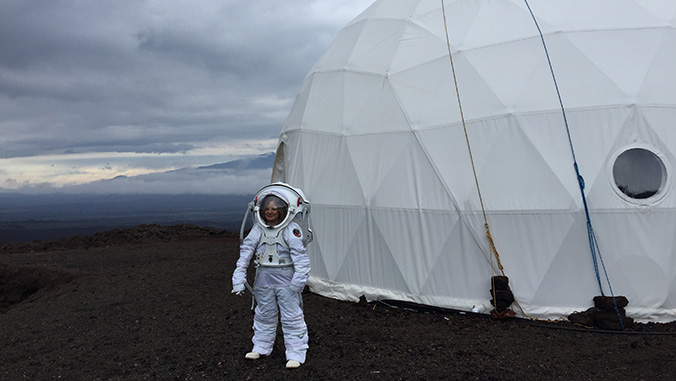
A two-week mission to perform scientific experiments and test technological instruments needed for the future exploration of the Moon or Mars commenced on February 20 at the University of Hawaiʻi at Mānoa’s Hawaiʻi Space Exploration Analog and Simulation (HI-SEAS) habitat on the slopes of Mauna Loa on Hawaiʻi Island.
The crew of six is under the command of UH Mānoa’s Michaela Musilova, chief investigator for HI-SEAS and the International Moonbase Alliance.
Musilova said, “These missions are open to researchers around the world to take part in, provided their research will help contribute to the exploration and colonization of the Moon and Mars.”
The mission is under the EuroMoonMars initiative, led by the International Lunar Exploration Working Group (ILEWG) of the European Space Agency (ESA), in collaboration with the International Moonbase Alliance (IMA), European Space Research and Technology Centre, Vrije Universiteit (VU) Amsterdam and HI-SEAS. It is part of a series of projects led by IMA, which is planning on building a moonbase on the Moon and a prototype moonbase on Hawaiʻi Island.

Other crew members are:
- Annelotte Weert—Dutch geologist, master’s student at VU Amsterdam/ILEWG
- Benjamin Pothier—French explorer/anthropology researcher, Plymouth University, Explorers Club member and journalist
- Josh Burstein—American journalist, host of Last Glimpse
- Nityaporn Sirikan—Thai/British/Italian systems engineer at ESA/ILEWG
- Sebastian Mulder—Dutch geochemist, master’s student at VU Amsterdam/ILEWG
The crew’s research includes geological and drone surveys, lava tube exploration and space technology testing. They will be doing outreach and education, including performing a research experiment designed by high school students in Slovakia who won a Mission to Mars competition last year organized by Musilova. The mission control centre for these missions is based at the Blue Planet Research laboratory on the Big Island, which is owned by the IMA founder Henk Rogers. Bernard Foing of ESA and executive director of ILEWG will be acting as the space-crew communicator at the mission control centre.
“These missions can be of much shorter duration than the previous missions that took place at HI-SEAS,” Musilova said. “We also have a different application procedure, which should allow for more diverse people to take part in them. Our hope is to get more UH researchers and students involved in future missions.”
Interested crew member applicants or for scientific project proposals for future missions, contact Musilova at musilova@moonbasealliance.com.
The current mission is scheduled to end on March 6, 2019 at noon. Media interested in covering the crew exit should contact Michaela Musilova, chief investigator, HI-SEAS, musilova@moonbasealliance.com or Amy Higa at (808) 536-2729, (808) 386-6790 or ahiga@iq360inc.com.

